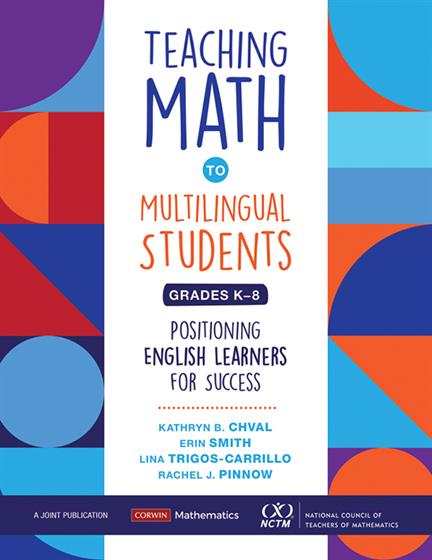Preface
Acknowledgements
Our Hope for Multilingual Learners
Teachers Who Inspire
Studying Teacher Practice
Interacting With Multilingual Learners and Their Families
Position Multilingual Learners as Classroom Leaders
What Research says About Positioning
Reflecting of Xiao Li's Experience
Reflecting on Nabil Abadi's Experience
Reflecting on José López’s Experience
Positioning Students as Experts
One Year Later
Reflecting on Why Positioning Matters
Recognize How Teachers Position Students
Positioning Multilingual Learners as Leaders
Explicitly Positioning Multilingual Learners as Leaders
Implicitly Positioning Multilingual Learners as Leaders
Strategies for Positioning Multilingual learners as Leaders
Thinking About Positioning in Your Practice
Facilitate Multilingual Learners' Participation in Mathematics Classroom
Reflecting on Your Experience with Participating
What Research Says About Student Participation
Factors That Influence the Participation of Multilingual Learners
Reflecting on Your Experiences with Fear
Overcoming Fear
Encountering Unknown Contexts
Examining Teaching Strategies That Influence Participation
Strategies for Facilitating Multilingual Learners’ Participation in Mathematics
Thinking About Participation in Your Practice
Facilitate Partnerships Between Multilingual Learners and Their Peers
Solving a Mathematics Problem with A Partner
Solving a Mathematics Problem with A Partner
Qualities of Partnerships
Strategies for Facilitating Partnerships
Establish Participation Norms With Students
Practice Compliments
Provide Concrete Resources
Pay Attention To Pairing
Monitor How Partners Work
Revisit Partnership Norms With Student
Thinking About Partnerships in Your Practice
Engage Multilingual Learners Through Culturally-Relevant Contexts
Reflecting on the Challenge of Contexts and Culture
What the Research Says About Contexts in Mathematics
Strategies for Engaging Multilingual Learners Through Culturally-Meaningful Contexts
Thinking about Contexts in your Practice
Reach Multilingual Learners with Visuals, Illustrations, and Gestures
What Research Says About Visuals and Gestures
Using Visuals Strategically
Examining Ms. Bristow’s Use of Visuals: Dividing Cookies
Examining Ms. Bristow’s Use of Visuals: Emphasizing the Meaning of ‘Loose’
Emphasizing Mathematical Connections
Reflecting on Your Use of Gestures
Using Gestures Strategically
Examining Ms. Bristow’s Use of Gestures: Obstacle Course
Examining Ms. Bristow’s Strategic Use of Visuals and Gestures: Columns and Rows
Thinking About Visuals and Gestures in Your Practice
Strategies for Using Visuals and Gestures
Analyze Mathematical Work of Multilingual Learners
Reflecting on Your Experiences
What Research Says About Analyzing Multilingual Learners’ Mathematical Work
What Research Says About Analyzing Multilingual Learners’ Mathematical Work
Analyzing Additional Student Work
Strategies for Discerning Between Mathematical and Language Issues
Examining Abigail’s Work
Examining Janessa’s Work
The Importance of Interviewing Multilingual Learners
Thinking About Analyzing Multilingual Learner’s Mathematical Work in Your Practice
Investigate Meanings to Enhance Multilingual Learners’ Language Development
The Importance of Academic Language for Multilingual Learners
What the Research Says About Academic Language
Distinguishing Between Multiple Meanings of Language
Introducing Specialized Mathematics Language
Amplified Use of Academic Language
Strategies for Enhance Multilingual Learners’ Language Development
Thinking About Academic Language in Your Practice
Use Your Discourse Strategically to Enhance Multilingual Learners’ Opportunity to Learn
Reflecting on Varieties of English that Influence Discourse
What Research Says About Discourse
Teacher Discourse
Connecting Academic Language to Mathematical Representations
Posing Questions to Engage Multilingual Learners
Posing Questions to Engage Multilingual Learners
Strategies for Promoting Classroom Discourse
Thinking About Your Discourse in Your Practice
Foster a Culture of Writing in the Mathematics Classroom
Reflecting on Your Experiences
What Research Says About Writing in Mathematics
Establishing a Need to Write in Mathematics
Establishing a Culture of Writing
Providing Feedback on Students’ Writing
Analyzing Students’ Writing
Strategies for Fostering a Culture of Writing in Your Mathematics Classroom
Reflecting on Mathematical Writing in Your Practice
Develop Writing in Mathematics for Multilingual Learners
Reflecting on Your Practice
Mathematical Genres of Writing
What the Research Says about Mathematical Genres
Identifying Mathematical Writing Genres
Strategies for Developing Writing in Mathematics for Multilingual Learners
Teaching Practices
Activities
Reflecting on Your Use of Mathematical Genres in Your Practice
Enhance Curriculum Materials for Multilingual Learners
Reflecting on Mathematics Curriculum
What Research Says About Curriculum Enhancement for Multilingual Learners
Strategies for Crafting Language to Better Support Multilingual Learners
Analyzing Curriculum Materials for Multilingual Learners
Research Recommendations for Enacting Mathematics Curriculum
Recognizing Different Mathematical Conventions and Representations
Thinking about Mathematical Conventions and Representations in your Practice
Thinking about Curriculum Enhancement in your Practice
Engage with Parents and Families of Multilingual Learners
Reflecting on Your Experiences
What the Research Says about Multilingual Parent and Family Engagement
Multicultural Parenting Styles
Cultural Values
Emphasizing the Value of Family in Your Classroom
Examining Teachers’ and Multilingual Parents’ Expectations
Reframing Multilingual Parental Engagement
Strategies for Facilitating Multilingual Family and Parent Engagement in Your Classroom
Reflecting on Family Engagement in Your Practice
Appendix A. Additional Resources
Appendix B. Selected Solutions
References






